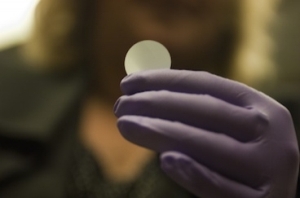Separating molecules is an important part of many manufacturing and testing processes, including pharmaceutical production and some biomedical tests.
One way of carrying out such separation is by using nanofilters — materials with holes of a precisely controlled tiny diameter, to allow molecules up to that size to pass through while blocking any that are larger. But a new system devised by researchers at MIT could add an important new capability: a way to selectively filter out molecules of the same size that have different chemical properties.
 Karen Gleason holds a filter that can selectively remove molecules of the same size that have different chemical properties.
Karen Gleason holds a filter that can selectively remove molecules of the same size that have different chemical properties.
Karen Gleason, an MIT professor of chemical engineering and associate dean of engineering for research, and postdoctoral fellow Ayse Asatekin described the process in a paper published this month in the journal Nano Letters.
This is “a fundamentally different way” of separating molecules, Gleason says. “People usually think of size as being the defining factor,” but by making the pores in the filter small enough so that there is a significant chemical interaction between the pore walls and the molecules passing through them, it becomes possible to discriminate according to other characteristics, she explains. In this case, the selection was based on the molecules’ affinity for water. Because the walls of the pores were hydrophobic (water repelling), other hydrophobic molecules were more easily drawn to the pores and propelled through them than were other, less hydrophobic molecules.
In living organisms, cell walls routinely perform this kind of chemical separation, letting certain specific kinds of molecules — for example, nutrients, enzymes or signaling molecules — pass freely through pores in a cell membrane, while blocking all others. But this is the first time, Asatekin says, that such chemical separation has been demonstrated in a synthetic membrane.
Many biological molecules that are similar in size yet have very different functions or properties, so the ability to separate them efficiently could be important. In this initial proof-of-concept demonstration, the molecules selected were two dyes, chosen because of their similar size and ease of detection. Using a polycarbonate membrane (a type of plastic) treated with a vapor-deposited layer of another polymer, the researchers were able to separate the two dyes very effectively, with more than 200 times more of one type passing through than the other. The coating process they used not only adds the capability for discriminating between molecules based on their differing affinities for water, but by coating the insides of tube-like pores in the material it also provides a way of creating extremely small pores of uniform size — much smaller than can be produced by conventional methods.
Joerg Lahann, an associate professor of chemical engineering at the University of Michigan who was not involved in this work, says that the team’s ability to produce tiny, uniform pores smaller than 10 nanometers (billionths of a meter) across is itself a significant accomplishment that solves a major problem in existing nanoseparation technology.
To test how the system works, the team tried making two different kinds of pores — some that were uniformly sized tubes, others that had a narrow bottleneck at one point and then widened out. The uniform cylinders were much more effective, demonstrating that the key factor is the interaction of the molecules with the wall of the pore over its entire length, which in this case was about 4,000 times the width.
In pharmaceutical manufacturing, many processes involve chemical reactions in which both the reactants and the chemical being produced are very similar in molecular size, so being able to separate the two efficiently could be a significant advance in allowing large-throughput processing instead of small-batch production as is done currently, Asatekin says.
In addition to possible applications in drug manufacturing, such membranes could be important for the detection of biologically significant molecules. For example, the U.S. military, which funded this research through the Institute for Soldier Nanotechnology, is interested in their possible use in detectors that could identify a chemical marker the body produces when an inflammatory response is triggered, which could be a way of quickly revealing that the body had been exposed to a toxin even without knowing what the toxin was.
As a next step, Asatekin and Gleason plan to try the technique to separate biomolecules that are of real relevance to biological processes, to demonstrate that it works for materials that would be of interest for actual applications.
Professor Mathias Ulbricht, chair of technical chemistry at the University of Duisburg-Essen in Germany, calls this a “powerful experimental demonstration” of a new technique that he says holds great promise for practical applications.
“This study opens a new avenue for truly ‘tailored’ nanoporous membranes with different selectivities than those of traditional membranes,” he says. “More experimental work toward preparation of membranes with varied structure and other separation experiments are to be done. However, I am optimistic that the promising prospects can be demonstrated practically in such follow-up studies.”
Source: http://web.mit.edu/